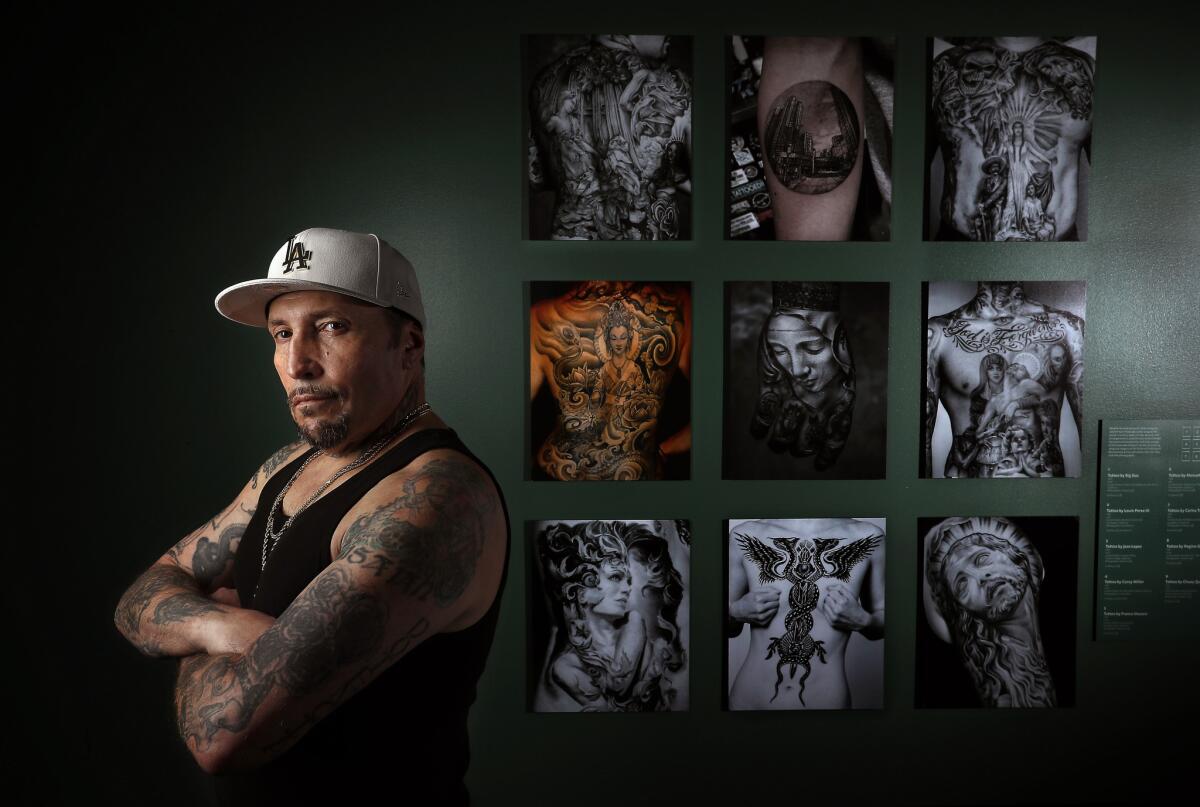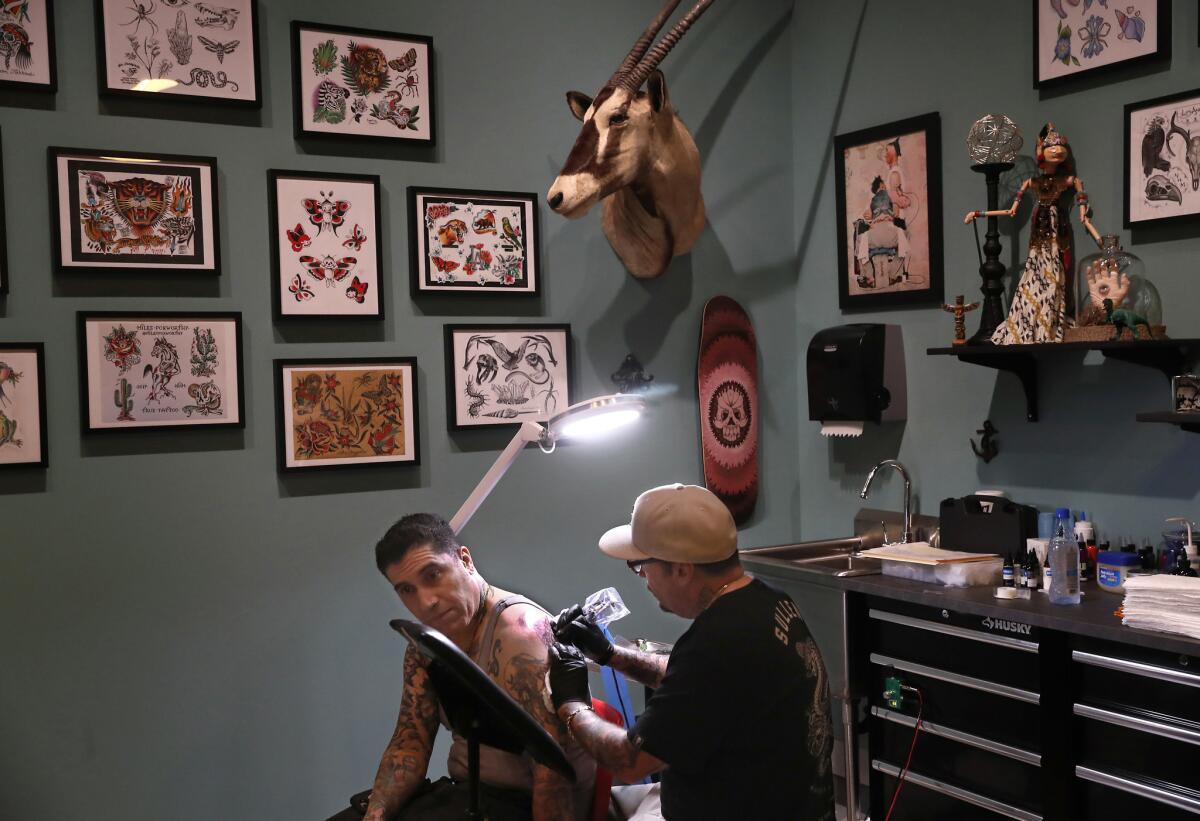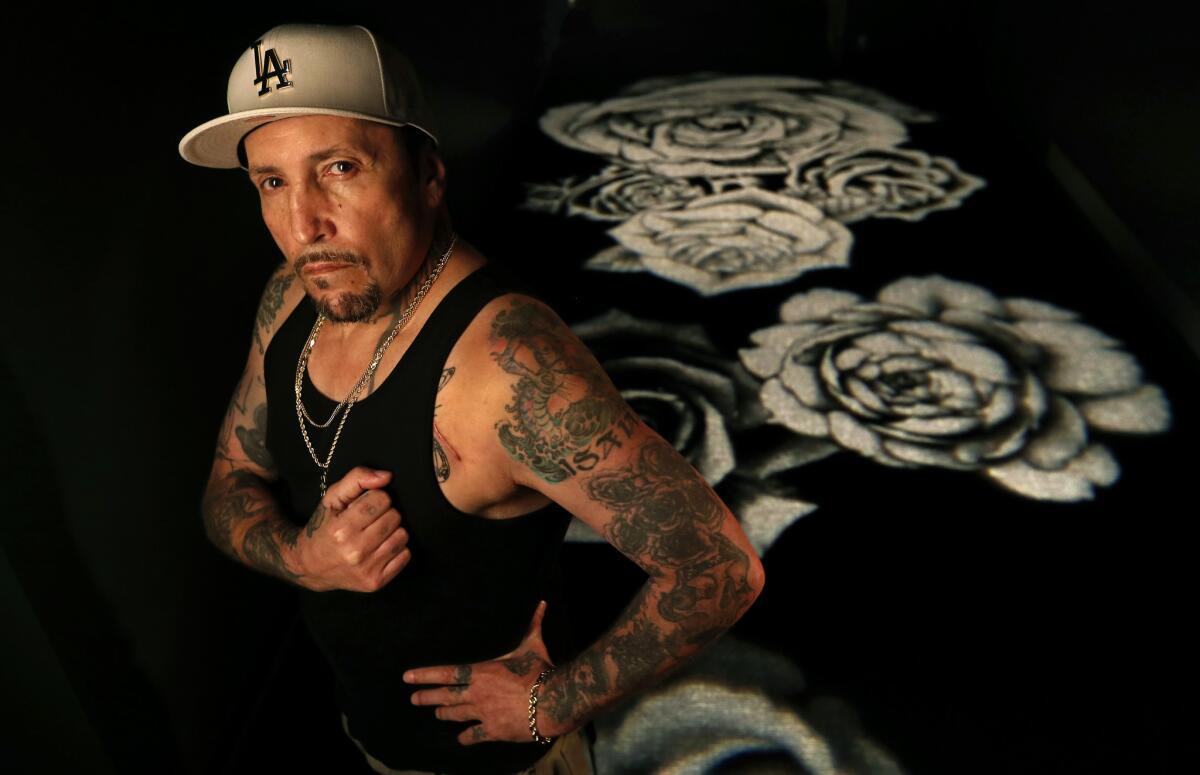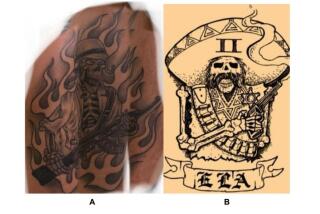Tattoo you: Freddy Negrete, the black-and-gray style and an L.A. museum’s new interactive exhibition

Freddy Negrete, the black-and-gray style and an L.A. museum’s new interactive exhibition.
- Share via
Freddy Negrete was 18 and serving time in a juvenile detention facility when the image came to him: the Greek masks of comedy and tragedy paired with the catchphrase “Smile Now, Cry Later.” It was 1974 and Negrete, a member of San Gabriel’s La Sangra gang, was incarcerated for a gang-related shooting. A talented artist, he passed his hours inking fellow inmates with tattoos in exchange for cigarettes or Top Ramen soup. The masks became his signature design.
Negrete made do with whatever materials he could get his hands on. Learning from other prisoners, he built a crude, single-needle tattoo machine with a Bic pen, a melted toothbrush, a cassette tape motor, a paper clip and a sharpened guitar string for the needle. He worked with black ink made from burned plastic ash mixed with water.
Giving and receiving tattoos gave him purpose and a sense of belonging.
“As Chicano, cholo gangsters, we had images that were very important to us,” Negrete says. “Revolutionary type images, Aztec Indian images, lettering, pachuco crosses — because we always wanted to say who we were and where we were from.”
Negrete is now considered a pioneer of the “black-and-gray” style of tattooing, marked by its fine lines, nuanced shading and realistic imagery. It developed in prisons in the West and on the streets of East L.A. in the 1970s. His work, along with other examples of the black-and-gray style, is on view at the Natural History Museum as part of the traveling “Tattoo” exhibition that opened Sunday.

The exhibition, organized by the Musée du quai Branly — Jacques Chirac in Paris and traveling to L.A. from Chicago’s Field Museum of Natural History, covers 5,000 years of tattoo culture with artifacts, photographs and multimedia. The show leads viewers from a display of tattoo tools dating to the 17th century to an exploration of why people across cultures and time periods got tattoos. One gallery dives into tattooing as a world heritage; another presents the exchange of artistic ideas between North America, Asia and Europe. There’s even a live Instagram feed on an interactive screen, with images of museum visitors’ tattoos.
“Now you walk down the street and almost everyone is tattooed. It’s mainstream,” says the museum’s vice president of exhibitions, Gretchen Baker. “But we don’t have this broader understanding of how this tradition came to be. So this exhibition is trying to take what you see on the streets and kind of unpack it, go deeper, understand that this is part of this bigger human impulse to mark our bodies.”
About a third of the exhibition is content original to the Natural History Museum. A primary goal, the museum says, is to showcase the role of women in the art form. The entrance gallery features original tattoo designs on lifesize silicon body parts. Front and center is a graphic octopus design by pioneering L.A. tattoo artist Kari Barba, who operates Outer Limits Tattoo in Long Beach, the longest continually running tattoo studio in the U.S., the museum says. Another gallery showcases the work of female tattoo artists in indigenous cultures; a video documentary depicts a 100-year-old Filipina woman, a member of the Kalinga tribe, training her niece in the art form.
The museum has built a working tattoo parlor, an amalgamation of classic California parlors, in which visitors can watch live demonstrations and get inked by one of 20 visiting artists.
L.A. has a deep and colorful tattoo history. A gallery toward the end of the exhibition tells the stories not only of the black-and-gray style but of the Long Beach Pike scene. The amusement park area boasted in the 1940s and 1950s the highest concentration of tattoo shops in the U.S., the museum says. It became a hub for American traditional tattoos that were colorful and cartoony — think “Mom” inside a bulbous heart — and during the war it was a popular stop for sailors passing through.
“I made this for the exhibition,” Negrete says, holding a vibrating, clunky tattoo machine powered by a roll of D-sized batteries. He’s on an early walk through the show, and the machine is part of a kitchenette installation that’s based on his apartment after he was released from incarceration in 1977. On the table is a dinged-up 1979 cassette player, a candle bearing the Virgin Mary’s image, his homemade tattoo machine, a shoe box and a row of tiny paper cups filled with black ink.
“When I got out of youth authority, the first thing I did was set up my prison-style tattoo machines in my kitchen, and I started tattooing people in there,” Negrete says, sitting down at the table.

His arms and neck are covered in tattoos — roses, skulls, butterflies hovering over handcuffs. He has 50 or so across his body, he says, mostly all inked during his time behind bars as a teen.
“Whereas [traditional-style tattoos] were happening in the brick-and-mortar parlors,” Baker adds, nodding at the apartment installation, “a lot of the black-and-gray style was happening in people’s kitchens and on the streets of East L.A. — that’s kind of where it all began.”
As the Long Beach Pike tattoo scene was waning in the 1970s, the black-and-gray style was picking up steam. Hoping to fill a void, tattoo artist Charlie Cartwright opened Good Time Charlie’s Tattoo Parlor on Whittier Boulevard in 1975 — considered the first professional tattoo parlor in East L.A. In addition to the American traditional style, he incorporated black-and-white realism there. Tattoo artist Ed Hardy bought the shop from Cartwright and changed its name to Good Time Charlie’s Tattooland in 1977, which is the year Negrete wandered in.
Stepping through the shop’s doors, Negrete saw designs that he had created in prison hanging on the walls. He told Jack Rudy, an artist who worked there, “Hey, those are my designs!” Negrete says.
“They said, ‘Everyone says that, that their uncle or somebody in prison designed it,’” Negrete recalls. “But I happened to have the original art on me and I showed them!”
Rudy hired Negrete to work at the shop. “So together, Jack Rudy and I and Ed Hardy introduced this new prison style of tattooing to the tattoo world,” Negrete says. “And Ed Hardy named it black-and-gray realism.”
Designs by Cartwright, Hardy
“One of the points we’re trying to make with the show is just how radically the black-and-gray style changed tattoo,” museum exhibition developer Danielle Sommer says. “Prior to black-and-gray, things were flat, they didn’t have dimension. Today, almost everyone who works in color is still really influenced by the style — because it’s not about the color, it’s about the shading and dimensionality. Anything you see that looks like it can jump off the skin, that’s because of black-and-gray.”
Negrete, who now works at the West Hollywood tattoo studio Shamrock Social Club, gazes up at a framed print of his “Smile Now, Cry Later” design on the museum wall, one hand absently stroking a tattoo-blanketed arm. The image is a cautionary tale of sorts, he says.
“You live the fast life, the hard life,” he says, “you’re smiling now, having a good time now, but you’re gonna pay later.”
Then he chuckles heartily.
“I’ve
“I spent so much time in jail when I was a teenager, and all I did was draw in there,” he says. “And the things that I drew were the images that reflected my culture. Tattooing, it identified you with a certain group, it said something about who you were.”

♦ ♦ ♦ ♦ ♦ ♦ ♦ ♦ ♦ ♦
‘Tattoo’
Where: Natural History Museum of Los Angeles County, 900 Exposition Blvd., L.A.
When: Ends April 15
Admission: Special exhibition, $11-$24, includes entrance to rest of museum
Info: (213) 763-DINO, nhm.org
Follow me on Twitter: @debvankin
MORE ARTS STORIES:
Grateful Dead banner art goes up for auction
Why your favorite TV show just might be scripted by a playwright
More to Read
The biggest entertainment stories
Get our big stories about Hollywood, film, television, music, arts, culture and more right in your inbox as soon as they publish.
You may occasionally receive promotional content from the Los Angeles Times.











